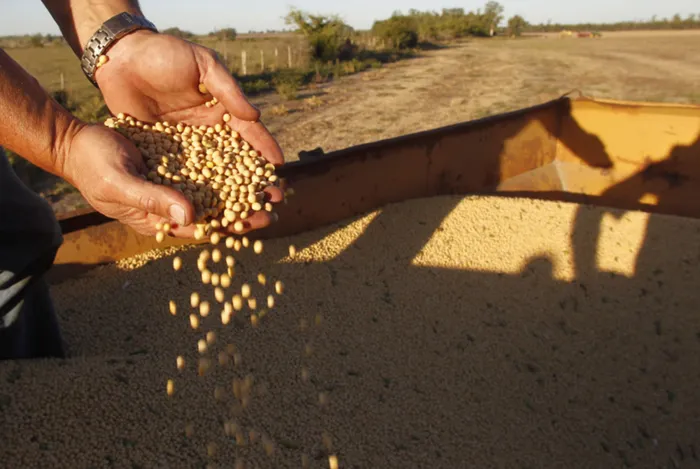Argentine farmers hoard soybeans as inflation hedge

File picture: Andres Stapff File picture: Andres Stapff
Buenos Aires - Argentine farmers are hoarding more soy this season than in past years, threatening to reduce much-needed export tax revenue as raw beans become the preferred unit of savings in an economy impaired by double-digit inflation.
The South American farming powerhouse is the world's No. 3 exporter of the oilseed at a time of increasing global demand.
Growers are stock-piling more and more soybeans on their farms, selling only 70 percent so far this season versus about 85 percent at this point last year, said Leandro Pierbattisti, an analyst with Argentina's grains warehousing chamber.
“They prefer to save by way of beans, which are synonymous with protection from inflation,” he said.
Market sources confirmed the trend. One Buenos Aires-based grains trader, who asked not to be named, said Argentine growers have sold 68 percent of their crop so far this year, while the average rate of export sales is 78 percent for this period over the last five years.
Independent agricultural economist Manuel Alvarado Ledesma estimates farmers are holding onto 28 percent of their 2012/13 soy crop, or 17 million tonnes of soybeans worth $7 billion from which the government could extract $2.4 billion in export taxes.
This is a problem for President Cristina Fernandez, as she ramps up state spending ahead of an Oct. 27 mid-term election that will determine the clout she has in Congress during her remaining two years in office. Soybean export taxes are a key revenue source for Argentina, which has been cut off from the global bond market since its 2002 sovereign default.
Depriving the government of funds is no problem for growers who have long opposed Fernandez's interventionist policies. They complain about her lack of inflation targeting, the 35-percent tax she put on soybeans and the export curbs she places on wheat and corn to ensure ample domestic food supplies.
Fernandez was re-elected in 2011 on promises of increasing the government's role in Latin America's No. 3 economy.
Her policies include heavy foreign exchange controls meant to limit access to dollars and stanch capital flight. She is criticised by orthodox economists for the passive approach she has taken toward inflation clocked by private economists at 25 percent per year, one of the highest rates in the world.
Santiago del Solar, who farms soy in Argentina's bread-basket province Buenos Aires, said farmers are retaining more beans this year than last due to financial uncertainty.
BIG U.S. CROP SEEN
The United States is forecast to produce 85.71 million tonnes of soybeans this year, the country's fourth biggest crop ever, according to the U.S. Department of Agriculture (USDA).
That estimate might go down next month when the U.S. harvest starts in earnest and the full effects of dry Midwest August weather are factored in. The U.S. crop will certainly be a robust one that keeps downward pressure on world soy prices.
“The market might be bearish over the midterm, depending on Brazil and U.S. crop forecasts, but people don't care. To an Argentine farmer beans represent dollars, which hedge against the biggest risk they face: inflation,” Pierbattisti said.
Chicago soy futures prices are down about 7 percent so far this year. But its not just the sale of beans that is in play.
Argentina is also the world's top exporter of soyoil, used in the booming international biofuels sector, and soymeal livestock feed used widely in China.
CRUSHING LESS SOY
“So far the lack of selling by farmers has not impacted Argentine soy exports. The real impact is on domestic crushing operations,” Pierbattisti said, citing data showing exports of 2012/13 soybeans at 6.2 million tonnes versus 4.4 million tonnes at this time in the previous season.
In the first seven months of this year, Argentina crushed 19.7 million tonnes of soybeans, down from 20.8 million in the same 2012 period, according to Andres Alcaraz, spokesman for Argentina's CIARA-CEC crushing and export industry chamber.
“Idle capacity is twice that needed to avoid an increase in fixed costs. This is not good for the competitiveness of Argentina's export industry,” he said.
As Argentina expands its crushing industry in anticipation of a jump in world food demand - the United Nations sees demand doubling by 2050 - idle capacity of soyoil and meal crushing plants is at 30 percent this year, below the 34 percent at this time last year when drought reduced Argentina's soybean crop.
Idle crushing capacity is also being pressured higher, along with soybean exports, by the strategic decision China has made to import more raw beans to be crushed on Chinese soil.
The USDA says Argentina produced 49.4 million tonnes of soy in the recently-harvested 2012/13 season, and has forecast output of 53.5 million tonnes in the 2013/14 crop year, which will start being seeded next month. - Reuters